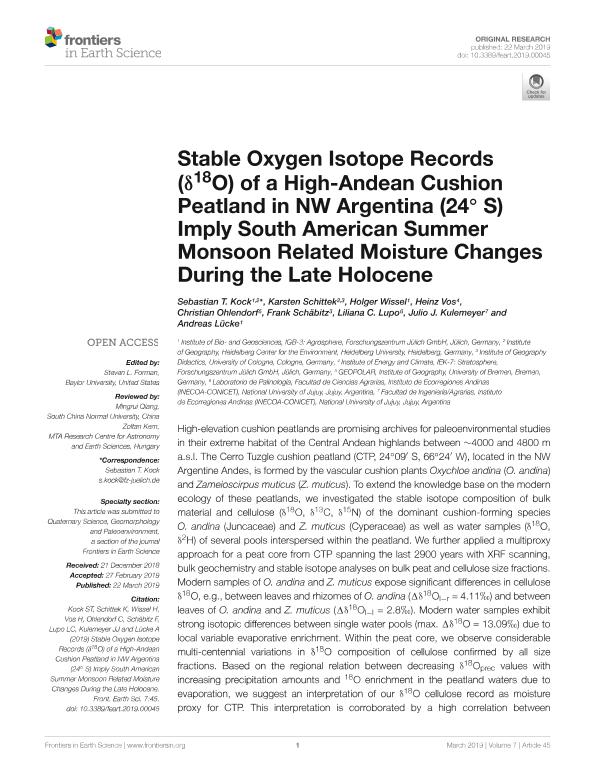Artículo
Stable oxygen isotope records (δ 18 O) of a high-andean cushion peatland in nw Argentina (24° S) imply South American summer monsoon related moisture changes during the late holocene
Kock, Sebastian T.; Schittek, Karsten; Wissel, Holger; Vos, Heinz; Ohlendorf, Christian; Schäbitz, Frank; Lupo, Liliana Concepcion ; Kulemeyer, Julio José; Lücke, Andreas
; Kulemeyer, Julio José; Lücke, Andreas
 ; Kulemeyer, Julio José; Lücke, Andreas
; Kulemeyer, Julio José; Lücke, Andreas
Fecha de publicación:
02/2019
Editorial:
Frontiers Media S.A.
Revista:
Frontiers in Earth Science
ISSN:
2296-6463
Idioma:
Inglés
Tipo de recurso:
Artículo publicado
Clasificación temática:
Resumen
High-elevation cushion peatlands are promising archives for paleoenvironmental studies in their extreme habitat of the Central Andean highlands between ∼4000 and 4800 m a.s.l. The Cerro Tuzgle cushion peatland (CTP, 24°09′ S, 66°24′ W), located in the NW Argentine Andes, is formed by the vascular cushion plants Oxychloe andina (O. andina) and Zameioscirpus muticus (Z. muticus). To extend the knowledge base on the modern ecology of these peatlands, we investigated the stable isotope composition of bulk material and cellulose (δ 18 O, δ 13 C, δ 15 N) of the dominant cushion-forming species O. andina (Juncaceae) and Z. muticus (Cyperaceae) as well as water samples (δ 18 O, δ 2 H) of several pools interspersed within the peatland. We further applied a multiproxy approach for a peat core from CTP spanning the last 2900 years with XRF scanning, bulk geochemistry and stable isotope analyses on bulk peat and cellulose size fractions. Modern samples of O. andina and Z. muticus expose significant differences in cellulose δ 18 O, e.g., between leaves and rhizomes of O. andina (Δδ 18 O l-r = 4.11‰) and between leaves of O. andina and Z. muticus (Δδ 18 O l-l = 2.8‰). Modern water samples exhibit strong isotopic differences between single water pools (max. Δδ 18 O = 13.09‰) due to local variable evaporative enrichment. Within the peat core, we observe considerable multi-centennial variations in δ 18 O composition of cellulose confirmed by all size fractions. Based on the regional relation between decreasing δ 18 O prec values with increasing precipitation amounts and 18 O enrichment in the peatland waters due to evaporation, we suggest an interpretation of our δ 18 O cellulose record as moisture proxy for CTP. This interpretation is corroborated by a high correlation between oxygen isotopes, peat growth and geochemical data. Accordingly, CTP indicates dryer conditions between 2190 and 2120, 1750 and 1590, 1200 and 1080 and since 130 cal. yr BP, whereas periods with increased humidity prevailed from 2750 to 2250 and from 600 to 130 cal. yr BP. Temporal changes in the match to South American Summer Monsoon (SASM) reconstructions suggest impacts of other large-scale atmospheric variability modes or a different SASM expression at our southerly location.
Archivos asociados
Licencia
Identificadores
Colecciones
Articulos(INECOA)
Articulos de INSTITUTO DE ECORREGIONES ANDINAS
Articulos de INSTITUTO DE ECORREGIONES ANDINAS
Citación
Kock, Sebastian T.; Schittek, Karsten; Wissel, Holger; Vos, Heinz; Ohlendorf, Christian; et al.; Stable oxygen isotope records (δ 18 O) of a high-andean cushion peatland in nw Argentina (24° S) imply South American summer monsoon related moisture changes during the late holocene; Frontiers Media S.A.; Frontiers in Earth Science; 7; 45; 2-2019; 1-18
Compartir
Altmétricas



